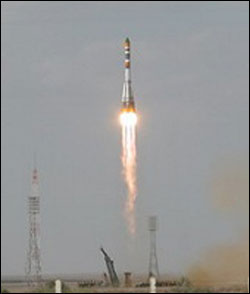European experiments successfully launched aboard Foton spacecraft

Successful launch of the Foton-M2 mission from Baikonur Cosmodrome
An unmanned Foton-M spacecraft carrying a mainly European payload was put into orbit by a Russian Soyuz-U launcher today at 14:00 Central European Time (18:00 local time) from the Baikonur Cosmodrome in Kazakhstan.
Following the launch and nine minutes of propelled flight, the Foton-M2 spacecraft is now in low-earth orbit where it will remain for 16 days before its reentry module lands close to the Russian/Kazakh border.
During the mission European experiments and equipment will be monitored by ESA’s Operations Team at the Payload Operations Centre based at Esrange near Kiruna, Sweden. They will be responsible for receiving, evaluating and disseminating scientific data generated by European payloads on Foton such as the Fluidpac and Agat experiment facilities. During 6 of the 16 daily orbits, the Foton spacecraft will be in a suitable orbital position for Kiruna to receive signals from it. Should any experiment parameters need adjustment, the commands will be sent direct from Kiruna to the specific experiment facility.
The European payload carried by Foton-M2 covers a scientific programme consisting of 39 experiments in fluid physics, biology, material science, meteoritics, radiation dosimetry and exobiology. The European Space Agency has been cooperating with the Russian Space Agency on this type of scientific mission for 18 years. With 385 kg of European experiments and equipment out of the overall payload of 600 kg, this mission constitutes the largest European contribution that has been put into orbit on such missions. The Foton-M2 mission provides reflight opportunities for almost the entire Foton-M1 experiment programme lost due to launcher failure on 15 October 2002.
Applied research plays a prominent role with heat transfer experiments in the European FluidPac facility, chemical diffusion experiments in the SCCO (Soret Coefficients in Crude Oil), and material science investigations in the Agat and Polizon furnaces. These experiments are expected to contribute, respectively, to new heat-exchanger designs, to more efficient oil exploration processes, and to better semiconductor alloys.
As on previous missions, biological research receives a great deal of attention, this time with the emphasis on fundamental questions about the origin and spread of life forms in the universe. Biopan, which is hosting most of these experiments, is making its fifth scientific flight on a Foton mission. Education is also playing a part in the mission with a germination experiment, which has come from ESA’s student programme.
“Foton is one of the very important platforms that ESA uses for experimentation in weightlessness,” said Daniel Sacotte, ESA’s Director of Human Spaceflight, Microgravity and Exploration Programmes, “and with more than half the total available payload being taken up by European experiments and hardware, this shows the efforts that Europe is making to expand the boundaries of research in space to help improve life on Earth.”
The mission is being carried out under an agreement signed between ESA and the Russian Space Agency Roskosmos on 21 October 2003 covering two Foton flights (Foton-M2 and Foton-M3, scheduled for 2007), which will have a combined total of 660 kg of ESA-supplied scientific payloads on board. The agreement also ties in two Russian partner companies: TsSKB-Progress in Samara and the Barmin Design Bureau for General Engineering (KBOM) in Moscow.
“This was the first Foton launch from the Baikonur Cosmodrome in Kazakhstan as all previous launches have been from the Plesetsk Cosmodrome in Russia” explains Antonio Verga, ESA’s Project Manager for Foton missions. “The Foton-M2 reentry module is expected to reenter earth’s atmosphere on 16 June and land in an uninhabitated area near the town of Orenburg, Russia, close to the Russian/Kazakh border. The capsule and the experiments will be recovered within a few hours of the landing. Time-sensitive ESA experiments will be flown back immediately to Rotterdam via Samara and turned over to researchers for analysis at ESA/ESTEC in Noordwijk, the Netherlands.”
Media Contact
More Information:
http://www.esa.int/esaHS/SEMZDJ0DU8E_index_0.htmlAll latest news from the category: Physics and Astronomy
This area deals with the fundamental laws and building blocks of nature and how they interact, the properties and the behavior of matter, and research into space and time and their structures.
innovations-report provides in-depth reports and articles on subjects such as astrophysics, laser technologies, nuclear, quantum, particle and solid-state physics, nanotechnologies, planetary research and findings (Mars, Venus) and developments related to the Hubble Telescope.
Newest articles

NASA awards SwRI $60 million contract to develop next-generation coronagraphs
SwSCOR will help NOAA predict geomagnetic storms and protect Earth assets. Southwest Research Institute has won a $60 million contract to build three coronagraphs for the National Oceanic and Atmospheric…

Hope for the treatment of people with severe burns
MHH researchers are developing an innovative drug to prevent the rejection of donor skin grafts. When people suffer severe burns, there is not only a risk of infection in the…

New Insights into Flowering Regulation
Impact of Carbon and Nitrogen Signalling on Floral Repressors in Arabidopsis. An international research team, including Dr Justyna Olas who is co-first author on this study, has uncovered fundamental mechanisms…



